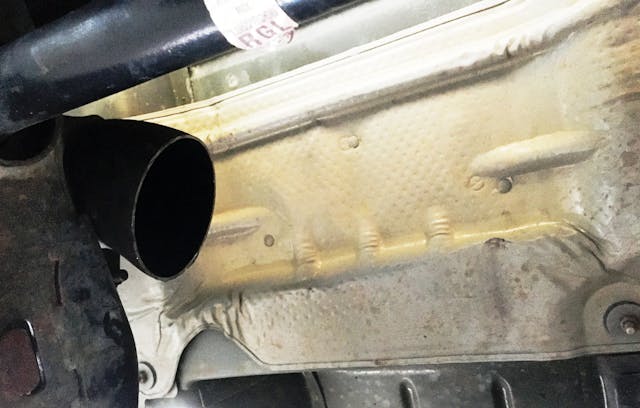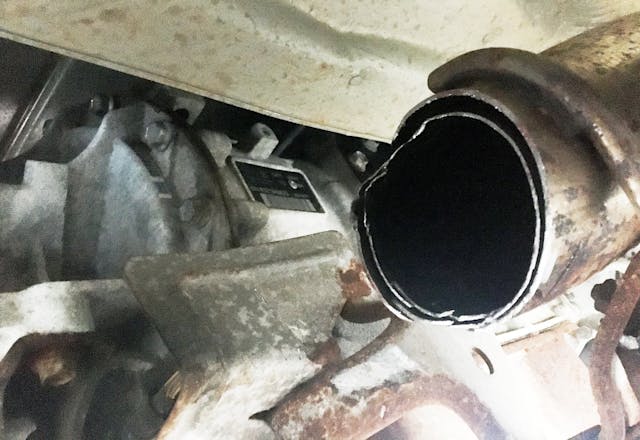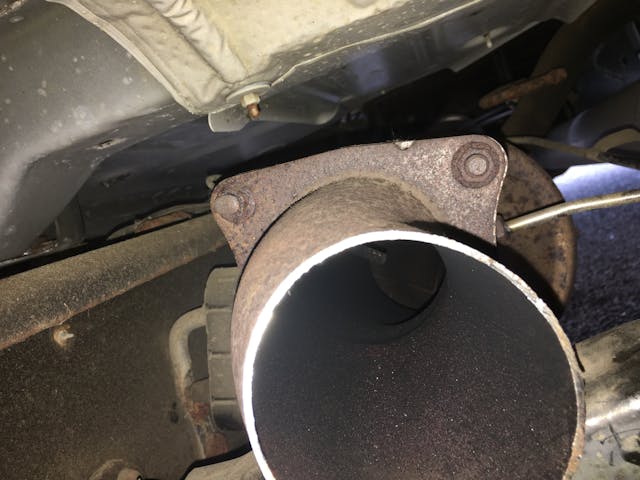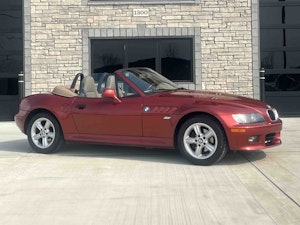Media | Articles
How I survived catalytic converter theft

I’ve written multiple times about my 2008 Chevy 3500HD Duramax diesel. How my former engineering job had largely abandoned the 28,000-mile truck when the company closed the building … how it became a gag-worthy mouse-infested mess … how I made a criminally low offer for it (that took four months to be accepted) … how I largely de-moused it … and how I thought I’d use it to buy and tow home a whole bunch of cars but instead have only moved two cars and a bunch of BMW parts with it, helped my niece move, made cardboard and motor oil recycling runs in it … and how I park it in a $50/month rented space about a mile from my house to make space in my driveway.
As if that isn’t enough, I never expected to add, “… and how I had to deal with a stolen catalytic converter.”
My discovery of the theft happened in a funny way. Prior to Thanksgiving, my wife had arranged to borrow one of those tall outdoor heaters from a friend so that we could put it on the back deck in case someone wanted to escape the crush of people inside for a bit—maybe have a beer and a private conversation outside. So, I walked over to the truck’s parking space (which is in the parking lot of a dance studio located right next to what used to be the town dump but is now the recycling depot), reconnected the batteries, and fired it up.
As soon as the truck was running, I could hear an unusual whirring sound, as if a blower fan was running. I never for a moment thought it could be a cut catalytic converter, as it wasn’t a big woof-y, truck-y exhaust sound. It was more the kind of air-movement sound a cooling fan makes if the viscous clutch is locked up. I opened the hood, but the sound wasn’t coming from there—it seemed to be emanating from below, near the center of the truck. I crawled under and guessed that the source of the whirring was the transmission. I realized this was the coldest it had been outside this season, and that I hadn’t changed or even recently checked the transmission fluid. Maybe that’s all it was.
So, I drove the truck on a quick errand to see if warming it up made the noise go away. It didn’t. When I got home, I looked for my mechanic’s stethoscope but couldn’t find it. I crawled under the truck again, listened to the noise, put my hands on the transmission pan, and convinced myself the noise was indeed coming from there. To avoid any damage, I decided not to drive it the 20-ish miles to pick up the heater and instead used the Winnebago Rialta (the little VW Eurovan-based RV). I made a mental note to, after Thanksgiving, take the truck into the local transmission shop, which had looked at the transmission on my Suburbans years back.
Marketplace
Buy and sell classics with confidence
The Monday after Thanksgiving, I set the plan in motion. I started the truck, crawled under it a third time to verify the presence and location of the noise, then drove it two miles to the transmission shop. I described the “whirring” sound to the shop owner. “Whirring, not whining?” he asked. I nodded. He looked perplexed and came outside to look at it. He stuck his head under the truck, and immediately said the last five words I expected to hear:
“Your cat has been cut.”

I was astonished—both that it had happened and that I had completely missed it. In my defense, aside from the exhaust sounding pretty much normal (particularly with the windows up), the cut sections of pipe where the catalytic converter once resided are close to the inside of the right frame rail. Even after the guy told me what had happened, I had to crawl way under and look up and to the right to see the cut pipes. On the drive back from the transmission shop, I did notice that I could hear more spin-down noise from the turbo on deceleration than I remembered. I assume that it’s the turbo’s presence in the exhaust (rather than having an open pipe coming down from the exhaust manifold) that made it not sound like a straight-piped menace.


Catalytic converters are stolen because they contain the valuable rare metals platinum, rhodium, and palladium to catalyze (react with) the exhaust. The scrap value is widely quoted online as being between $300 and $1500. Toyota Priuses are prime targets for cat theft because the hybrid vehicle’s cat contains a higher concentration of these precious metals than most other cars. Catalytic converter theft has been a hot topic for awhile, but it has accelerated dramatically in recent years, reportedly because mining of these materials was affected by the COVID-19 pandemic. In early November, there were news reports of federal authorities busting a company in New Jersey and arresting a nationwide ring of cat thieves, and there is legislation advancing at the state level to engrave the Vehicle Identification Number (VIN) into cats as a theft-deterrent. Diesel trucks used to be overlooked due to their cats working differently—they don’t contain rhodium, and thus having much lower recycling value—but their high ground clearance and easy cat access has recently made them targets.
I, of course, never gave any of this a second thought. I live in Newton, Massachusetts, one of the safest small cities in the country. I haven’t had a vehicle vandalized since we moved here from Boston 30 years ago. And I don’t own a Prius.
When it happened, of course, hindsight kicked in. This is a big dually truck that you can practically limbo under while wielding a battery powered Sawzall. My parking spot in the lot next to the town recycling center is in an industrial area. And the fact that many people likely saw the truck sitting for weeks made it a likely target. It’s a wonder it didn’t happen sooner.

So, after you shake your fist and swear at the lowlifes who cut the cat out of your ride, what do you do? The basic sequence is:
- File a police report. My local police station is processing several cat thefts a day (“mostly Priuses”).
- Contact your insurance company to find out your coverage. If you file a claim, you’ll likely need the police report, which is why I listed it as the first step.
- Learn what the laws are in your state. That may be a rude awakening. California, for example, requires the catalytic converter in all vehicles to be either the OEM part or an aftermarket State Air Resources Board-approved unit, and prohibits generic catalytic converters that are based solely on physical shape, size, configuration, or pipe diameter. Other states are likely more accommodating, but you’ll need to check.
- Get several estimates. As with nearly any repair, having it performed at the dealership will be the most expensive option.
Be aware that, in addition to state laws, certain Federal laws are in play. The first is that, not surprisingly, it’s illegal to remove a cat and replace it with any kind of bypass pipe. Another is that it’s illegal to sell or install a used catalytic converter unless it has been properly recertified, which involves testing and labeling. I doubt that black helicopters are going to swoop down on you if you buy a used cat and install it yourself, but what it means is that established independent repair shops likely won’t want the risk of offering it to you as an option. And technically, it’s illegal to be operating the vehicle with the cat removed, although it would take particularly bad luck on your part for that to be discovered, and a police officer would need to be having a particularly bad day for you to be written up about it, especially if you had the copy of the police report of the theft with you.
Regarding the hazards of short-term driving of the vehicle with the cat cut out, there are several issues. The first is whether the remaining sections of the exhaust are dragging or scraping against anything, as along with the cat, the thieves may have chopped out a hanger that supports the center of the exhaust. If you hear scraping, unless you’re a mechanic and can either ascertain that it’s a trivial issue or wire the exhaust in place, don’t drive the car—call for a tow.
Then there’s the health issue of the presence of exhaust fumes that are now likely gushing out directly under the car. This is the kind of thing you don’t want to be wrong about, particularly if you’re about to drive in traffic with children or infants as passengers. Err on the side of safety. The third is whether it’s harmful to the engine to drive with the exhaust open and the cat missing. For short distances, like to get the car repaired, it’ll likely be fine, but without the cat to clean the exhaust, the oxygen sensor after it (if it’s still there after the car was butchered with a power saw) is going to give readings to the vehicle’s electronic control unit (ECU), which will likely cause the check engine light (CEL) and potentially other dashboard indicators to come on. Depending on the car, it’s possible the ECU may throw it into a reduced-power limp-home mode. So, it’s best to drive it as little as possible.
In my case, I’m blessed with being a do-it-yourselfer and not needing to have the truck repaired quickly. After looking at the problem for a few days, here’s how it’s panning out:
- The part that was taken—the OE General Motors “oxidation catalytic converter” (#15283013) used on trucks with Duramax LMM engines from 2007 through 2010—lists for $1837 with a $400 core charge (which, of course, I don’t have, BECAUSE IT WAS STOLEN). Discounted online dealer price is as low as $1200, but with the core charge, shipping, and taxes, it comes to nearly $1750. Plus, there’s a gasket, a clamp, and a hanger. You can see how if, you took it to a dealer, you could get quoted three or four thousand dollars for the job.
- I have never, ever, deleted a catalytic converter from a car, and I have zero interest in starting now (yeah, I know; someone else already deleted it, but I need to do something to be able to drive the truck, and that is not going to be a bypass pipe).
- I have a $2000 deductible on my truck’s comprehensive insurance. This means that I won’t be filing a claim and instead will either fix it myself or try to find some small low-overhead shop (e.g., not a dealer) to do it.
- The original cat on the truck is welded between two pieces of double-walled 4-inch pipe. On the front end, it’s attached to the engine with a heavy-duty band clamp, and on the back end, has a four-bolt flange that’s bolted to the Diesel Particulate Filter (DPF). So, if I want to replace the whole cat assembly myself, it looks like it comes off fairly easily (or as easily as any old exhaust bolts come off).


- When the cat was removed, so was the post that a rubber hanger attaches to, so the front part of the back of the exhaust is currently just resting on a frame cross-member. I’m lucky that it is, or the whole thing could’ve tilted down and ripped out the lines plumbing the DPF. Even the cat notwithstanding, I’d be foolish to drive it anything but short distances at low speed until it’s properly hung.
- Instead of replacing the whole section, if I want instead to have someone weld a new compatible aftermarket catalytic converter into the existing pipes, it looks to me like there’s still enough of both pipes present to allow it. That is, if I can find someone to do it. I called two shops that have done custom exhaust work for me over the years. The first one won’t touch it, because they don’t know that much about diesels and aren’t sure which cat would be needed to properly play with the DPF. The second shop said they’d need to see it but ballparked it at $1500 job and said they couldn’t get to it for two weeks because—ready?—they need to install new cats in a fleet of 56 city trucks, all of which had them stolen.
- A vendor on eBay sells recertified cats for GM trucks and has the one I need in stock, shipped, for about $800. That price initially went tilt with me, but now is looking pretty good.

- Let’s say that, for the sake of argument, there wasn’t a law against installing an uncertified used cat, and that I went looking for such a thing as a less expensive option. What I may or may not have found after searching for several hours on Facebook Marketplace and Craigslist for a cat for a 2007–
10 Duramax LMM was one guy in northern Maine selling a complete low-mileage exhaust system for $650. When I hypothetically asked whether he’d sell me just the cat and ship it, he hypothetically declined.
- I also may or may not have seen ads on Facebook Marketplace and Craigslist for inexpensive used cats from the previous generations of Duramax diesels (the ones before the DPF became a federally mandated component), and while the bends of the pipes and the connections on the ends look the same as mine, they’re not listed as cross-referencing. I posed a question on the Duramax Diesel forum, but no one answered it definitively. A friend who knows diesels (but not Duramaxes) says the cat on a diesel with a DPF is a diesel oxidation converter whose job is to oxidize the fuel being injected into the exhaust to create enough heat to burn the soot out of the DPF, and that the previous generation of cat wouldn’t do that. Thus, it’d be iffy to buy one of them. If I saw them. Or was even looking for them. Which I may or may not have been.
- Let me cut the weasel-wording. I’m a practical guy who tries relentlessly to contain cost on 13 vehicles, and this is a truck I barely drive. If the only two options were 1) Take it to the dealer and pay up to my $2000 deductible, or 2) Entertain the possibility of buying some cheap, used, high-mileage catalytic converter assembly that would hang and seal the exhaust but might not perform the intended emissions function due to age or compatibility or both, you can see how the second option might be tempting. And if my truck was high-mileage, finding another high-mileage cat like the one that had been taken might seem justified. However, this is a 28,000-mile vehicle. Even the legality notwithstanding, the idea of finding and installing a $150 200,000-mile cat just doesn’t sit well with me.
For all these reasons, I pulled the trigger on the $800 eBay recertified cat. After a bit of back-and-forth, the vendor (KGC Warehouse) was kind enough to knock $100 off the price, which was greatly appreciated, especially considering that it was the only correct click-and-buy recertified cat I could find.
Lastly, there’s the question of preventing it from happening again. In the Prius world, there are now click-and-buy cages and shields you can install that make the cat more difficult to remove. I haven’t seen such a product for the truck, but it’s probably not too difficult to fabricate an aluminum plate. But really, I’m hoping that simply parking the truck down at the end of the driveway of my house on my sleepy dead-end street instead of in the highly visible parking lot next to the town recycling center will make the difference.
Sigh.
If you’re like me, you absolutely hate to be put into a situation where you feel put over a barrel and have to pay an insane sum of money simply to regain functionality that you already had. After all, this isn’t something fun like fresh paint or a hot engine or new wheels or new Recaro seats—it’s a freaking catalytic converter that some scumbag stole. At least I’m getting out of it for closer to washing machine money than Hawaiian vacation money.
***
Rob Siegel’s latest book, The Best of the Hack MechanicTM: 35 years of hacks, kluges, and assorted automotive mayhem, is available on Amazon. His other seven books are available here, or you can order personally inscribed copies through his website, www.robsiegel.com.












Rob, I enjoy reading your stories and am sorry that this theft happened to you. However, after reading this and other articles you have written, I have a question for you. What went through your mind when you typed, “I’m a practical guy who tries relentlessly to contain cost on 13 vehicles, and this is a truck I barely drive.”? Have you ever added up the cost of purchase, maintenance, insurance and storage of this fleet of seldom driven vehicles? If I was in your position, I would sell all but the vehicles you can’t store for free, replace the RV with a trailer and rent a truck as needed. With the money saved you could rent a (insert sports car name here) several times a year and probably still be money ahead. One down side of this is that you would lose subject matter to write about. On second thought, keep the fleet! I enjoy your humorous writing style and would not want you to have writer’s block.
I think it would be fun to catch someone stealing a CAT. Persuade them that it was a bad idea.
This whole business of cats being stolen is very frustrating. Until DA’s start going hard against thieves there is little to no incentive for thieves to stop. Our criminal system seems to be completely messed up on purpose.
I have never heard of anyone not noticing how loud it when started, and I have seen quite a few here in California. Maybe not a diesel though, could that be why.
The most effective solution would also be the simplest. A federal law declaring the rare metals in converters to be strategic materials, and therefore illegal to possess a catalytic converter (not attached to a vehicle) without a detailed chain of custody or manifest; i.e., the VIN of the vehicle from which it was removed, when removed, by whom, the reason removed, and the final destination (a federally authorized and certified recycler only). Don’t have that paperwork? You’re presumed guilty of receiving stolen goods and/or possession of prohibited materials.
So we just toss aside our rights because someone is stealing a catalytic converter?
Innocent until proven guilty is kind-of a foundational cornerstone of our republic.
I see where you’re going, but we already have laws against felony theft.
Do you see where I’m going?
There are many states that will confiscate large sums of cash as proof of illegal activity. All part of the civil asset forfeiture. In the old days, those were Highway men and the term sitting shotgun applies to coach guards.
If that’s the trend you seek, let’s divide this place up now, peacefully. Unlike the last time.
Well, we’re talking about crooks here, with lots of easy money as the incentive. I’ve no doubt that your idea might slow things down a tad, and add a degree or two of difficulty, but in the end, it wouldn’t stop them. I submit the example of stolen guns for instance. All manufacturers are required to put serial numbers on the product. Does that deter gun theft? It does not. All felons are restricted from having firearms. Does that stop them from acquiring stolen guns (or in some cases, just buying them outright from lazy sellers)? It does not. If I steal a gun and have no paperwork for it, does that stop me from finding a buyer? Nope. Lots of things are declared illegal. And yet bad people do ALL of those things. Every. Single. Day.
The short answer is that you can’t just legislate away greed and avarice.
True, if you have laws they should be enforced, not have others added on top of them just so the lawyers can make more money. No offense to the honest attention there.
attorney not attention.
No, you were right the 1st time. You can’t use honest and lawyer or attorney in the same sentence.
VIN numbers on the cats are a great help – ONLY to the thieves and scrap yards because it enables them to look up the exact make and model and pay the listed rate instead of inspecting, weighing and otherwise spending time on the piece.
Great point.
The lack of offending noise when started is normal for a turbo. Here in Ontario, turbos are considered “noise reduction devices” just like mufflers in the legislation.
DuraMax Diesels do NOT have Catalytic Convertors. They have DPF SCR & DOC exhaust systems. But NOT Cats.
Agreed. As I said in the piece, It’s a “Diesel Oxidation Converter,” and the GM parts catalog labels it as an “oxidation catalytic converter.” But for brevity and to put it in the overall context of catalytic converter theft, I referred to it as a cat.
Rob, WHAT WERE YOU THING….. you park a 3/4 ton truck next to a RECYCLE CENTER in Boston and thought something, if not the whole truck, would NOT get stolen…. Come on… A big neon sign would have been less notice to the scumbags….
What I’m most impressed by is the fact that someone as sharp and experienced as Rob can totally misdiagnose a problem by overlooking a large part that’s completely missing. This is reassuring since it’s pretty much EVERY SINGLE troubleshooting episode I go through with our cars, to the extent that the mechanic who works on them has to turn away to keep from laughing when I try to tell him what I think the problem is.
I guess I am glad that my newest vehicle is an 03 E39 wagon with 218k…Out here,they seem to be only interested in the later vehicles which would make sense based upon the materials used to construct them vs the old……The flower shop vans where Pam works which are 01 and 2 Fords,have been hit twice each in the last year…….
Thank you, Mr. Siegel. Your eclectically compelling car-guy writing is soothing to my soul. I am very sorry you had to suffer this criminal assault on your property.
Mr. Siegel lives in Newton, Massachusetts, one of the safest small cities in the country yet the second shop said they’d need to see it but ball parked it at $1500 job and said they couldn’t get to it for two weeks because—ready?—they need to install new cats in a fleet of 56 city trucks, all of which had them stolen. I too live in a relatively safe area of my county but unfortunately close enough to the unsafe city of Houston their scum has infested our county causing our crime rate to rise too. Not too long ago an off duty constable caught some thieves in the act of stealing his converter so they shot him to death.
Regarding protection for your cat, there is a company that makes a clamp on device that uses (I believe) aircraft quality cable to make sort of a cocoon around the cat so even if cut off, they couldn’t get it out.
Rob, sorry to hear this happened to you. Thievery makes one feel so terribly violated. I’m glad to hear that you, like me, consider removing or gutting catalytic converters to be wrong. I actually removed a straight pipe from my ’85 911 and added a cat when I bought it (way cheaper back in the day), and reinstalled the cat on my 1989 325i after rebuilding its engine to 2.9 liters. I see no reason to further befoul the air with my cars. The bill for our abuse of planet earth is presently coming due, and it’s ugly.
GREAT WELL WRITTEN ARTICLE THANK YOU MR SIEGEL VERY INFORMATIVE.